This is the third installment of our “Top 20” series, looking at the greatest players for a specific franchise based solely on Wins Above Replacement.
Quibble if you will about advanced statistical methods, but WAR is a handy way to make a list like this. I hope you enjoy my stroll through these twenty players, and as always I welcome comments below.
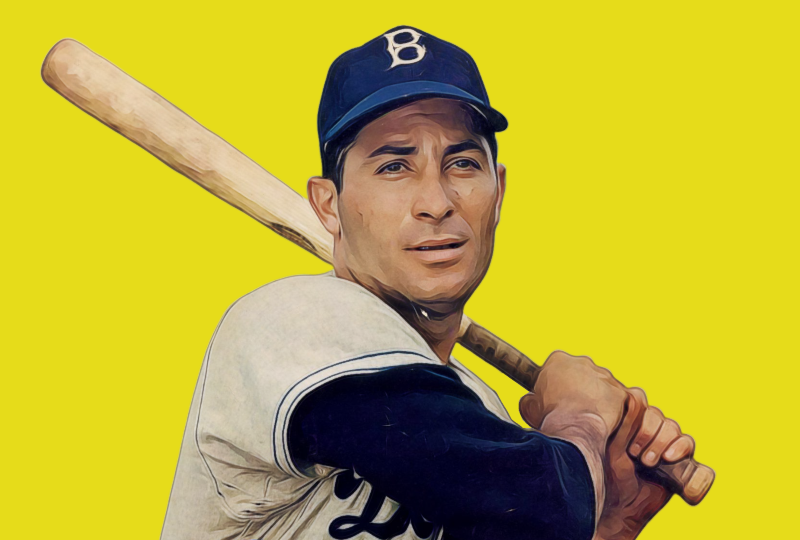
Of all the “Boys of Summer,” Furillo was the most tragic. That’s saying a lot considering: Campy suffered paralysis in a car accident that ended his career, Robinson died at 53 after suffering the loss of his oldest son and enduring several health problems, and Hodges dropped dead of a heart attack at the age of 47. Furillo’s problems stretched out for more than two decades and they started with a dreadful separation from the Dodgers.
By his mid-30s. Furillo’s body was betraying him. Teammate Junior Gilliam once said of Furillo: “He’s the strongest man I’ve ever seen.” But by the late 1950s, after several All-Star appearances and receiving MVP consideration in eight of 13 seasons, all with the Dodgers, Furillo’s back was killing him. In 1959 he lost his job in right field, and in 1960 he could barely play. In May the Dodgers released him, five days after he played what was his final game. His unceremonious release cost Furillo thousands of dollars in salary and pension compensation, and he sued the team, but that insult was just the beginning.
Nearly broke and with a crooked back, Furillo was forced to take menial jobs, working in construction and as a night watchman. He worked well into his 60s, and his efforts to get a good-paying job in baseball always came up short. He died in 1989 at the age of 66.
Furillo finished one hit shy of a .300 career average. He had 1,910 hits in 6,378 official at-bats for a mark of .2994. If he had gotten hit #1,911, his mark would have improved to .2996, which rounds up to .300, a magical mark in the record books.
He usually hit fifth in the vaunted Brooklyn lineup behind Campanella, with Duke Snider hitting third, Pee Wee Reese second, and either Robinson or Gilliam leading off. That left Hodges to hit sixth, which is a helluva lineup.
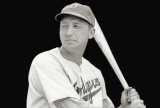
Walker was a line-drive hitter with a beautiful swing from the left side of the plate. He hit the ball hard a lot, sort of like Al Oliver. He had success everywhere he brought his bat, whether it was during his eleven years in the National League or eight seasons in the American League. He was well traveled, playing for five teams in 18 seasons. But more than 60 percent of his games were played in a Dodger uniform.
Walker played for Brooklyn when the team was transitioning from a laughingstock to a contender. In 1941 when the Dodgers won their first pennant in 21 years, Walker was a useful piece, batting anywhere from leadoff to second, to third, to lower in the powerful Brooklyn lineup. With Joe Medwick and Pete Reiser, he was part of an outfield in which they all hit over .300 for the season.
Dixie hit .306 for his career and collected more than 2,000 hits. He hit a lot of doubles and earned a reputation as a clutch hitter. He hit .296 as a pinch-hitter and reached based more than one-third of the time in that role for his career. He averaged 106 RBI in the four seasons from 1944-47. But ’47 was the last season the Dodgers employed him, for good reason.
Jackie Robinson arrived in 1947, integrating the major leagues. Walker was a Georgian with staunch views on race, and they were not progressive. He was also a hard-ass. He usually had a beef with one or two teammates every year, regardless of their color. He had two dust-ups while he was a young player with the Yankees, helping to escalate on-field incidents. In 1938 while in a Tiger uniform, Walker made an obscene gesture to fans at Briggs Stadium. When Arky Vaughan was his teammate in Brooklyn, Dixie formed a contingent of “southern” ballplayers who divided the clubhouse. There was an incident where Walker created such animosity after sliding into an opposing player in Chicago that police were stationed near the Dodger dugout for two days the remainder of that series.
Having Robinson as a teammate was difficult for Walker. He didn’t believe that blacks possessed the skill or intellect to play baseball with whites. On the other hand, he gradually acknowledged that Robinson was talented. Walker and Robinson never had problems, but basically Dixie ignored his teammate that year. Walker was one of a dozen Dodger players who signed a petition in spring training to keep Jackie off the team. After the season, in which Brooklyn won the pennant but lost the World Series, Walker asked to be traded. The Dodgers dealt their #3 hitter to the Pirates.
Later in life, Dixie Walker worked as a scout and he even signed black players to contracts. He came to change his mind about race and expressed regret about his attitude toward integration. People can change, and Walker had.
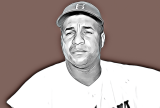
Campanella didn’t play his first game in the major leagues until after his 26th birthday. By that time he’d been a professional ballplayer for more than a decade. Had the game been integrated, he probably could have been in the “white” big leagues by the time he was 20, maybe even 19. But then World War II gets in the way, so there’s that. Still, he could have logged another 500 games in the majors. That would have put him at 1,700+ games and somewhere over 300 homers and more than 1,000 RBIs. He was clearly an impressive power hitter from the moment he entered the majors with the Dodgers in 1948.
It’s often forgotten that established players like Campy took a pay cut when they transitioned from the negro leagues to Major League Baseball. According to some reports, Campanella made $650 per month playing for Baltimore Elite Giants prior to signing with Brooklyn in 1946 for $125 per month. That’s a hurt on the wallet.
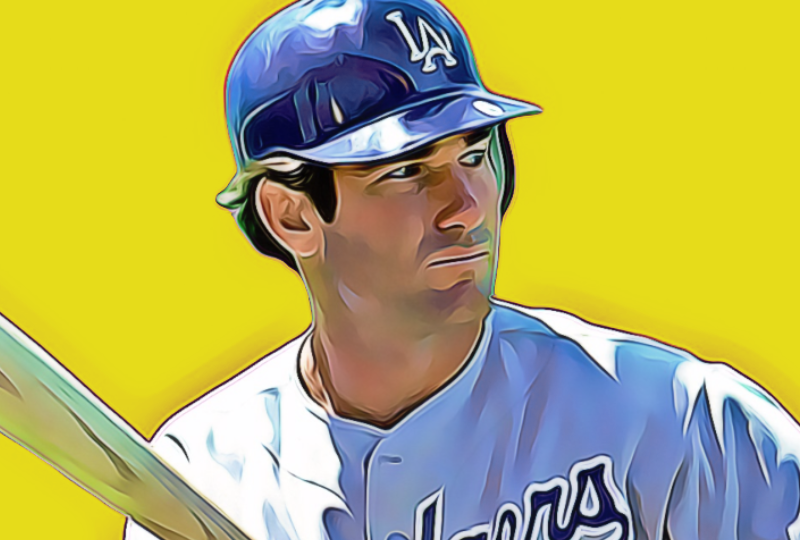
For the first five years of his pro career, Garvey was a third baseman, until an arm injury prompted the Dodgers to move him across the diamond . What if he hadn’t made the switch, would he be a better Hall of Fame candidate?
Garvey’s peak was from 1974 to 1980, seven seasons. He posted a 828 OPS and 130 OPS+ over that stretch. Virtually all of that was earned with his bat. Garvey was notoriously mediocre defensively. Following the arm injury, he had little ability to throw the ball, and opposing batters knew it. But what if he’d never suffered an arm injury and been able to play even an average third base? Luckily, we have his teammate Ron Cey to use as a comp.
From 1974 to 1980, Cey posted an 829 OPS and 129 OPS+. Virtually identical to Garvey. That’s just the part with the bat. Garvey had 27 WAR via his offense during that span and was about -6 WAR with his glove. Cey earned 31 WAR with the stick and 7.6 with the glove. The defensive side of WAR is not just how the player performs, but also includes a “position adjustment.” Third base is one of the most demanding positions on the field. Just by standing at third base for 162 games, Garvey would have earned more WAR “credits” every year. Given seven years at third base, even if he was playing the hot corner like Pete Rose, Garvey would have been a more valuable player. Would it have changed the perception of him in the eyes of Hall of Fame voters? Possibly.
Hall of Famer Ron Santo had similar offensive numbers to Garvey (albeit he accumulated them mostly in the 1960s when runs were more at a premium). On the other hand, Mike Schmidt was in the league at the same time as Garvey, which means the Dodger star wouldn’t have gotten the All-Star love he did, nor the same attention. Plus, we have no way of knowing if Garvey could have played more than 1,200 straight games at the hot corner, and that streak was another part of his résumé.

According to baseball-reference.com, Fernando pitched in front of more fans than any other pitcher in baseball from 1980 to 1990. That’s true even though Fernando missed six weeks to injury in 1988 and only made two starts in 1980.
Starting Pitchers, Highest Attendance (1980-1990)
Fernando averaged nearly 40,000 fans for his starts between 1980 and 1990, all of those coming with the Dodgers. He made 320 starts, won 141, tossed 29 shutouts, including one no-hitter. He was one of the greatest financial assets any team has ever had. I suppose you’d have to put Babe Ruth first, and Mark Fidrych was huge for about 50 starts, but when it comes to a starting pitcher over the course of their career, Fernando might have been the most popular player in baseball history.

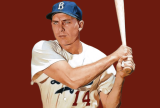
There’s no difference between Gil Hodges and Tony Perez or Eddie Murray, two other first baseman renowned for being clutch RBI middle-of-the-order guys after him. All three played on dynastic teams of their era. Hodges drove in 100 runs seven times and at least 90 runs eight times. Perez did it seven times and 12 times, while Steady Eddie did it six times and 12 times respectively. Perez won two World Series titles with the Big Red Machine, Murray got one with the Orioles, and Gil got two (one in Brooklyn and one in LA).
But Hodges didn’t fair as well in MVP voting. Perez logged three top ten finishes, Murray had an impressive eight, including two runner-up finishes. Hodges only ranked in the top ten in NL MVP voting twice, in 1950 and 1957. There are three likely reasons for this:
First, MVP voting in the 1950s was much different. Voters valued skills that later became less important, which resulted in middle infielders and catchers getting a larger bulk of support even if their offensive numbers were only mediocre. For example, in 1949 Hodges finished 11th in MVP voting behind Red Schoendienst, a second baseman who hit .297 but had only three homers and 54 RBIs. In 1954, Hodges had perhaps his best season, slugging 42 homers with 130 RBIs and 106 runs scored. He finished only tenth in MVP voting, behind teammate Pee Wee Reese, who hit just 10 homers and had 39 fewer extra-base hits. Alvin Dark finished ahead of him too, despite hitting half as many homers and having far fewer extra-base hits, walks, and RBIs. Apparently if you could hit somewhere around .300 and play shortstop, you were more valuable than a first baseman who hit 40+ homers.
Secondly, pitchers drew a lot more MVP consideration in that era, in fact the Cy Young didn’t exist for much of Hodges’ career. Make that the rule during the careers of Perez and Murray, and the totals change a bit.
Lastly, Gil Hodges was probably a slightly less impressive player than Perez or Murray. I think that’s because Hodges played with several iconic players in an eight-team league, a smaller pool. His teammates overshadowed him. Robinson was a flashy athlete and strong team leader. Snider was the classic superstar with a picture-perfect swing and a handsome smile. Campanella was a sturdy field leader. Pee Wee was a runt, an underdog, a fan favorite. Furillo had an arm that made people “ohhh” and “ahhh” like they’d just seen majestic fireworks. Koufax was a regal figure who grew into mythic status. Even Junior Gilliam had a loyal following and was revered for his savvy play. One season, when Gil hit 32 homers, Gilliam got four first-place MVP votes while Hodges got none, not for first place or any other. Eight of his teammates got votes. Hodges was often the odd man in the shadows when it came to honors. On the “Boys of Summer,” he was the “other brother,” like Zeppo Marx.
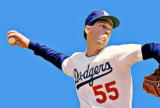
As more time elapses, we tend to simplify our opinions on players. Especially if the player did something very memorable. People remember that Kirk Gibson hit a clutch home run off Dennis Eckersley in the World Series, but forget that he had an excellent (in fact, quite thrilling) career in addition to that one at-bat in the Fall Classic.
Hershiser was Gibby’s teammate on that ’88 Dodgers team, and he was the main reason they won the pennant and Fall Classic that season. Unfortunately for his legacy (but fortunately for the Dodgers), he had a record shutout streak that season and an epic run in the postseason that’s become what most people remember about him. But there was a lot more.
Hershiser’s best season was 1988 when he had a 7.2 WAR, according to baseball-reference. In 1989 he posted a 7.0 WAR, and his best seasons after that were 6.4 (1987), 5.9 (1985), and 4.3 (1984). That’s not a lot of seasons over 5.0, but it’s still a very good peak performance. After some arm trouble, Hershiser had some serviceable seasons in the 1990s and ended up pitching until he was 40 years old. He won 204 games and pitched in more than 500 games.
But it’s his peak season and the remarkable shutout streak that many people remember. He deserves to be remembered for more than that.
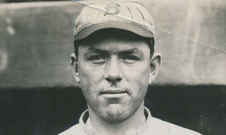
Rucker was the original Dodger lefthanded ace. (Though the team wasn’t known as the Dodgers when he toed the rubber: they were alternately called the Robins or my personal favorite, the Superbas).
He makes this list through a quirk in WAR, since he pitched so many innings in the deadball era. From 1908 to 1912 Rucker averaged 315 innings per season. His win/loss record was never good because Brooklyn was a terrible team in the early 20th century, but he was a good pitcher. In his starts, Brooklyn was a .500 team, but when he didn’t start they won at a lowly .430 pace, according to baseball historian Eric Enders. Still, his ERA+ of 119 is comparable to that of Bob Lemon, Billy Pierce, and Ron Guidry, but he didn’t pitch as long as those guys, racking up only ten years in the majors because he developed a sore arm.
Rucker was a little bit like Frank Tanana: he came in as a hard thrower and transitioned into a slow-tossing southpaw after shoulder trouble. Around about 1913, when he was 28 years old, Rucker started employing a looping breaking ball that confounded hitters and even confused his own catchers. But unlike Tanana, Rucker didn’t have a long career as a junkballer, he retired before his 32nd birthday. The reason seems to be that his sore arm never really went away.
In his final season, Rucker was used sparingly, about every ten days or so, a lot like Ted Lyons later with the White Sox, sort of a once a week pitcher. But Rucker was more like a twice a month pitcher, hopping onto the mound only nine times in 1916. In a nice touch, Brooklyn manager “Uncle Robbie” Wilbert Robinson called on Rucker to pitch in the World Series that fall, sending him into Game Four at Ebbets Field against the Red Sox to mop up. Rucker pitched two scoreless innings and struck out three Boston batters with his painfully slow and peculiar breaking pitch. It was his last appearance in the big leagues.
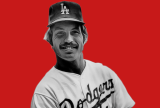
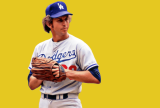
For seven years, from 1972 to 1978, righthander Don Sutton and southpaw Tommy John were teammates on the Dodgers. For six of those years they shared spots in the LA rotation. (John missed the last two-and-a-half months of the 1974 season and the entire ’75 campaign when he suffered a severe shoulder injury). But when they were both healthy, each was a masterful pitcher. Both pitched effectively into their 40s and each of them ranks among the all-time leaders in games started and innings pitched. Both Sutton and John were control specialists and both were usually overshadowed on pitching staffs with more famous pitchers. Each of them plied their trade with several teams after leaving the Dodgers, with much success. Both hurlers pitched and won big games at various stages of their career.
Sutton is in the Baseball Hall of Fame, and John is not. The righty has 324 wins to his credit, while John is 36 wins behind at 288, still an impressive figure topped by only a few dozen men in baseball history. His supporters for Cooperstown point to his longevity, his success, and the historic nature of the recreation of his left arm. As the years pass, Sutton will remain among the legends of the game, while John will probably fade into history. But which of the two pitchers was better: Sutton or John?
In the six years they were teammates, John made 174 starts and put up 116 quality starts (67 percent). The Dodgers were 110-63 in games the lefthander started, for a .623 percentage. Meanwhile, Sutton started far more games (242) and posted 163 quality starts (also 67 percent). The Dodgers played at a .603 clip in Sutton’s starts. The team scored 4.5 runs per game for John and 4.3 for Sutton, so there wasn’t much difference there. John was clearly one of the best lefties in the NL during that span, fashioning an excellent 2.97 ERA and a 1.22 WHIP. But Sutton was better: in the same rate stats, Sutton came in at 2.90 ERA and 1.08 WHIP. When they were in the same uniform, Sutton was more valuable: he made more starts, pitched deeper into games, and performed better despite getting a little less run support. Sutton threw 30 shutouts, while Tommy had only 11. Sutton was still doing what starters had done for decades: pitch into the ninth inning as a workhorse. John, even before his arm injury and famous surgical procedure, was a 7-inning pitcher. WAR confirms the lopsided edge in Sutton’s favor for those seasons: 27.0 WAR to 15.1 for John.
As far as their careers, if you like ERA+, John came out ahead at 111, while Sutton was 108. But Sutton pitched 500+ innings more than Tommy did, and that counts for a lot. Sutton pitched two brilliant games in the 1974 playoffs that greatly helped the Dodgers get to the World Series, where he won another game. He was 6-4 in the postseason and pitched pretty well in most of his starts. He also pitched and won Game #163 for the Brewers in 1982 to win the division title. John pitched even better in the postseason, posting a 2.65 ERA in 13 starts and going 6-3 for the Dodgers, Yankees, and Angels. In the 1981 World Series he was on the other side of the Yankee/Dodger rivalry and he was the only pitcher to beat the Dodgers in the series. He actually pitched against Sutton’s Brewers in the 1982 ALCS, but the two former teammates didn’t start against each other.
I think it’s clear that Sutton was a great pitcher, though he was admittedly pretty plain and as a result was in the shadow of several teammates. John wasn’t flashy either, and his style was more deceptive as he pushed his way past the age of 46 in the big leagues. But given his unique story and great success in three decades, and with 288 victories, I think he deserves a Hall of Fame plaque too.

In his final season, Koufax made 41 starts for the Dodgers. In 30 of those starts he went at least seven innings and allowed two earned runs or less. In his last two seasons he made 82 starts and in 25 of them he pitched at least eight innings and allowed two earned runs or less. He had 36 games in those two years (44 percent of his starts) with ten or more strikeouts. The lefty had 16 consecutive quality starts in 1966, 10 straight in 1965, and streaks of 11 and 10 in 1964. For those three seasons (1964-66) the southpaw was as dominant as any pitcher has ever been. There was a reason they called him “The Left Arm of God.”
Quality Starts by Sandy Koufax in his peak years
1962 … 17 in 26 starts (65 percent)
1963 … 31 in 40 starts (78 percent)
1964 … 24 in 28 starts (86 percent)
1965 … 35 in 41 starts (85 percent)
1966 … 36 in 41 starts (88 percent)
Total … 143 in 176 starts (81 percent)
It’s hard to have a long losing streak when you have a stud like that on the mound every four days. And Don Drysdale was pitching in the same rotation too, which tells you why the Dodgers won three pennants in those seasons and two World Series titles.
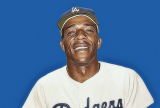
For twelve years he wore #3 for the Dodgers and he also hit a lot of triples, so Davis gave himself his iconic nickname of “3-Dog.” He was famous among his teammates for his colorful sayings and strange behavior. Dodgers’ executive Buzzie Bavasi once said of Willie: “There was nothing more exciting than to watch Willie run out a triple. He could have been a Hall of Famer, but he had million-dollar legs and a 10-cent head.”
Davis still holds several Los Angeles Dodger franchise records, including: runs scored, hits, extra-base hits, at-bats, runs, triples, and total bases.
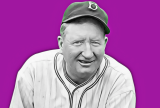
If you take the strikeout titles won by Drysdale and Koufax, they equal the K titles won by Dazzy Vance, seven. Vance, whose real first name was Charles, won his strikeout titles in consecutive seasons from 1922 to 1928. He also captured an MVP award and won 50 games in 1924-25. Amazingly, all of that — and all of his 197 wins — came after his 31st birthday.
Vance probably underwent one of the first exploratory surgeries in baseball history when a medical friend performed the procedure on his right shoulder in 1915. Almost overnight, Vance went from sore-arm to throwing one of the best fastballs in professional baseball. The Dodgers were just miserable enough to take a chance on a 31-year old with zero big league wins in 1922. The righty pitched a complete game in his first start for the Dodgers and went on to win 18 games that season. From that point on, Dazzy was one of the most feared pitchers in the league.
Over the course of his 11-year career as a starter for Brooklyn, the Dodgers won at a .598 clip in games Vance started, while the team played at .472 in all other starts. He also had a lot of touch luck losses. In 1927 in July he pitched four straight complete games and had a 2.57 ERA in the starts but lost each game as his teammates managed only five total runs for him. He was deservedly elected to the Hall of Fame in 1955, twenty years after his final big league pitch and six years before he passed away.
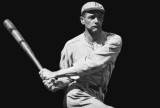
As great as Wheat was in left field, which he manned for Brooklyn for 17 seasons, his greatest ability came with a bat in his hands. He ranked in the top five in slugging five times, OPS four times, in hits six times, in doubles four times, in homers four times, in RBIs three times, and in extra-base hits five times. He also won a batting crown in 1918 and finished in the top five seven times overall.
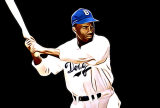
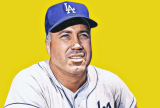
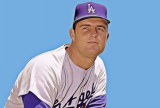
The tall, lean righthander from Van Nuys pitched his entire 14-year career in a Dodger uniform, helping the team to five pennants and three World Series titles. In the ’65 Series against Minnesota he struck out 15 batters and only walked three but split his two starts. His victory in Game Four was crucial however, evening the series and setting the stage for Koufax to start and win two of the final three games. That was the Series where Koufax refused to start Game One because it was on Yom Kippur, so Drysdale started on short rest and got rocked by the Twins, exiting in the third inning. When Walt Alston came to the mound to take him out, Drysdale quipped “I bet you wish I was Jewish too.”
Like a lot of the Dodgers of his era, Drysdale appeared on several TV shows. He made cameos on The Brady Bunch, The Donna Reed Show, The Rifleman, The Beverly Hillbillies, The Flying Nun, Leave It To Beaver, and even The Greatest American Hero in the early 1980s, long after he’d retired from a sore shoulder.
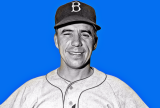
Reese was a marbles champion in Louisville, that’s how he got the name Pee Wee. But you might have already known that. Most kids don’t know what marbles are or how to play it anymore.

Three future Cy Young Award winners were drafted in the first round of the 2006 MLB Draft: Clayton Kershaw, Tim Lincecum, and Max Scherzer. In fact, all three have won at least two Cy Youngs. All three also tossed at least one no-hitter (Scherzer has two). At their peak all three were incredible, but only two of them can make the Hall of Fame. Lincecum’s arm injury, which seemed inevitable because of his violent motion and small frame, ended his pitching career at the age of 32. But with three Cy Youngs and already one 300-K season under his belt, Kershaw is destined for Cooperstown. Scherzer is still adding to his credentials. and in 2021 he became Kershaw’s teammate.
How do you select an all-time Dodger starting rotation? You have to start with Koufax, he has to be on it. Then there’s Kershaw and Fernando, two more southpaws. Don Drysdale and Don Sutton could balance your rotation very nicely, thank you very much, But that leaves off Orel Hershiser and Bob Welch, not to mention Burleigh Grimes and Dazzy Vance, a pair of Hall of Famers from yesteryear. No matter which five you pick, one thing is certain: you wouldn’t need a bullpen.
This feature list was written by Dan Holmes, founder of Baseball Egg. Dan is author of three books on baseball, including Ty Cobb: A Biography, The Great Baseball Argument Settling Book, and more. He previously worked as a writer and digital producer for the National Baseball Hall of Fame, as well as Major League Baseball Advanced Media.
No reproduction of this content is permitted without permission of the copyright holder. Links and shares are welcome.
No posts found!